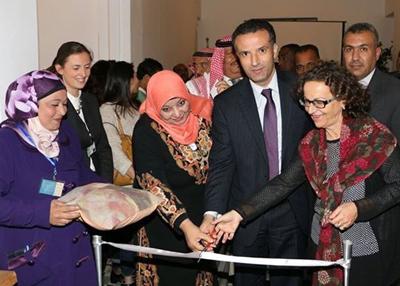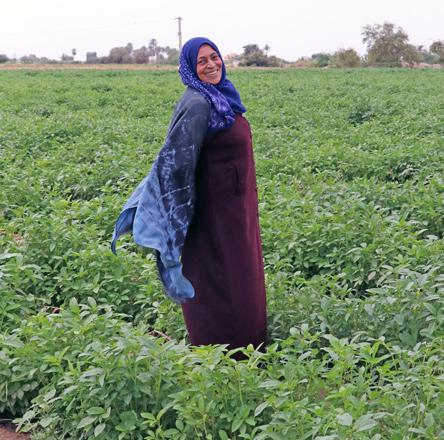You are here
Naturally dyed fabrics by women of Ghor Al Safi showcase 'colours of Jordan'
By Hind Joucka - Dec 10,2015 - Last updated at Dec 10,2015

Tourism Minister Nayef Al Fayez inaugurates an exhibition to showcase products by Ghor Al Safi women in Amman on Wednesday (Photo courtesy of Tourism Ministry)
AMMAN — UNESCO on Wednesday launched an exhibition of handcrafted and naturally dyed fabrics created by rural women from the Jordan Valley as part of a women’s empowerment programme.
As part of its project “Empowering Rural Women in the Jordan Valley”, UNESCO, in partnership with Al Hima Foundation and the Ghor Al Safi Women’s Association, is hosting the exhibition “Colours of Jordan” to showcase products by 14 women from the south of Jordan.
The exhibition continues through Saturday at Shams Al Balad Café in Jabal Amman.
Funded by Drosos Foundation, the project aims to empower rural women in Ghor Al Safi by helping them make their handicraft activities sustainable and provide them with income-generating opportunities.
UNESCO Representative to Jordan Costanza Farina said the project opens new horizons for women’s ambitions and creates opportunities to support their communities.
“It has been rewarding for us to collaborate with these women in creating innovative income opportunities over the past few years. They have succeeded at intertwining history, culture and capacity development and improving the livelihoods of the local community,” she said.
The event celebrated “Safi Crafts”, a collection of hand-dyed and eco-friendly textiles such as pillowcases and reusable shopping bags created using colours made from soil and natural dye plants.
The president of the Ghor Al Safi Women’s Association, Nofeh Nawasra, highlighted the importance of supporting and expanding this project and its effect on women and their communities.
“The results of the project helped empower a lot of women by providing them with a sustainable income for themselves and their families,” she said.
“Some of the women have started their own businesses, some completed furnishing their houses and some were able to pay for their children’s university tuition fees,” she told The Jordan Times.
Myassar Ajaleen, a member of the association, said the project has helped her provide for her family and rely more on herself.
“I didn’t have a source of income before I started working with the association. After a couple of years of working with them I was able to save up and start my own small business selling home-made pastry. I was also able to provide my children with university education without the help of anyone else,” she said.
Since 1999, the women of Ghor Al Safi have produced hand-dyed textiles using the colourful soil and natural dye plants of Jordan.
According to UNESCO Project Officer Valentina Gamba, during the past two years the women successfully revived the ancient indigo industry to obtain a natural blue colour, for which the Jordan Valley was famous in the past.
“We involved international and Jordanian experts to establish a cultivation pilot in order to plant the crop and harvest it, and create the natural blue colour. It is the first time in Jordan that natural blue is back to the market and this is a very big achievement for the heritage of the country,” she told The Jordan Times.
Tourism Minister Nayef Al Fayez attended the opening of the exhibition.
This initiative is part of UNESCO’s global campaign #Unite4Heritage, which supports safeguarding cultural heritage and cultural diversity around the world.
Related Articles
AMMAN — A project that utilises the colourful soil and natural plants of Jordan to produce hand-dyed textiles in the Jordan Valley is testam
AMMAN — As most dye used for our daily life products have become synthetic, natural dye from Indigofera tinctoria (also known as “true indig
Three experts from Oman concluded a five-day visit to Jordan on Thursday during which they shared their expertise on the ancient tradition of indigo harvesting, processing and dyeing with members of Ghor El Safi Women’s Association, according to a UNESCO statement.


















